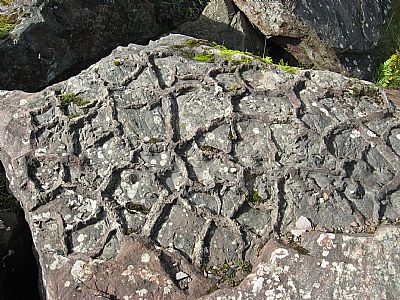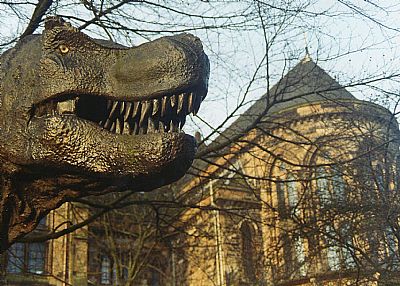FOSSILS
The story of fossils is directly tied to that of geology. The Geological Society of Glasgow introduces the subject. Fossils are the remains of once living organisms. They can be anything from the original shells and bones to their burrows and footprints. Scotland has a long and fascinating geological story. It has taken almost 3000 million years and a journey around the globe, welding together parts of several of the Earth’s tectonic plates, to become what we know today as Scotland. Throughout this time, it has witnessed many of the significant changes in life on Earth, from the smallest microbes to the mighty dinosaurs, many of which are now extinct.
In the past, Scotland has been a desert, a tropical swamp, a mountainous landscape with volcanoes, and an ocean floor, all of which have been witness to several ice ages. We know this from the rocks, and the fossils they contain, that are all around us and beneath our feet. [Geological Society of Glasgow].
West Dunbartonshire is not particularly rich in true fossils; remnants of ancient creatures and plants. But we do have some very interesting features worthy of consideration.
"FOSSILISED" MUD.
That may not immediately seem very exciting. But let's ponder that for a while.
Scotland had a very different climate in its geological infancy. Extreme dry periods only occassionally interpersed by rains can lead to ponds drying out quickly.

This picture was taken at Faerie Knowe on Carman Muir. It shows large segments of stone that have been upended during quarrying many years ago. What you are seeing are the positive imprints of cracks in mud when a susbsequent layer of mud or clay settled over the dessicated lower layer. FAERIE KNOWE - CARMAN QUARRY, CARMAN HILL
Peter Marrison records a similar feature near Murroch Burn for Geograph. https://www.geograph.org.uk/photo/8043978
CORNSTONE
Also on Carman Muir are the remnants of cornstone workings. These were the quarrying of such stone for its lime content. Although not as pure as the whiter limestone variety, it was nevertheless extracted for firing on a commercial basis.
You will be aware of working lime deposits, that lime can be used for fertiliser, for paint, render and mortar. You will also be aware that lime is a sedimentary carbonate rock and that it originates from marine organisms from what had been seabed. The definition geologically is rather complex, but in simple terms “Cornstone” is a name given to coloured limestone and by contrast is of terrestrial deposit.

Tailings of cornstone extracted from the ground and ready for removal for processing that never happened. Carman Muir. CORNSTONE WORKINGS, CARMAN MUIR
FOSSILISED PLANTS
Not far from Carman Muir, in fact towards its western edge, is Auchensail Quarry. It is now disused and within a farm of that name. The Scottish Geology Trust's GeoGuide gives some interesting information. It is rather technical, but it concludes with : Auchensail Quarry is accorded GCR site status because it has yielded an exceptionally well-preserved suite of Early Devonian (Emsian) land plants. The quarry also provides a good section of the interbedded sandstones and mudstones/ siltstones of the Teith Sandstone Formation, the youngest Early Devonian formation in the Midland Valley of Scotland. [GeoGuide]. The geology here is important as it shows a dyke rising to the surface which has large rafts of spiny plant axes.
The paper refers to this site as being in West Dunbartonshire. We point out that this would have been under the historical boundary and has since become within the Argyll and Bute side.
DINOSAURS
The term dinosaur refers to a fossil reptile of the Mesozoic era. Here we should include other creatures of that and periods of similar antiquity, such as fish and primitive mammals.
Geologists (who study rocks) and palaeontologists (who study fossils) have divided time into more manageable sections.
- Cambrian : 541 - 485 Ma. ("Ma" refers to millions of years ago. Parts of Scotland have produced fossils such as trilobites indicating that it was below the sea.
- Ordovician : 485 - 443 Ma. Scotland was still south of the equator and below the sea. Trilobites, starfish, bivalves and brachiopods have been found.
- Silurian : 443 - 419 Ma. The sea level dropped as the continents collided, bringing England and Scotland together for the first time. The fossil remains found include trilobites, shellfish, huge sea-scorpions (known as eurypterids), pod-shrimps and early jawless fish. The earliest animal to have walked on land was a millipede that was found in rocks near Cowie, near Aberdeen.
- Devonian : 419 - 359 Ma. Scotland was still south of the equator during the Devonian period, but was steadily moving northwards. ... Nearly 400 million years of erosion has reduced these mountains to the hills we know today....lakes trapped fish that are preserved in ancient dried-up pools where they died at Dura Den in Fife. [GeoGuide].
- Carboniferous : 359 - 299 Ma : Scotland moved from the equator to just north of it. It was a time that saw lush forests in an equatorial to tropical climate. .... the sea level rose and fell sev
- eral times. Scotland was frequently inundated by warm shallow seas, producing sediments of thick fossiliferous limestones. At other times it was blanketed by tall trees and plants, which produced much of the coal we mine today.... The Bearsden Shark is the best preserved shark of its kind ever found and is associated with shrimps that still preserve their muscles and blood vessels! The land was covered by tropical swamps where forests of large fern trees and club-mosses flourished. Giant centipedes, dragonflies and spiders ruled the landscape along with amphibians and early reptiles, the forerunners of the dinosaurs. [GeoGuide]. This website has a tantalising reference to a Pederpes, an Early Carboniferous tetrapod from Dumbarton, but doesn't elaborate. A Pederpes is a very important entry into the fossil record as it represents the first tetrapod to evolve to a primarily terrestrial (land based) lifestyle. [Prehistoric Wildlife]. Another website, Earth History notes the following : The fossil Pederpes finneyae, from near Dumbarton, was named after its finder Peder Aspen – who had the same number of digits on his foot (pes), or pes, as this animal – and its preparer Sarah Finney.

`A reconstructed impression from the Earth History website. © See link below.
- Permian : 299 - 252 MA. : By the early Permian, all the continents of the world were joined together in one vast super-continent called Pangaea. Scotland lay ‘sandwiched’ between America and Europe and moved further north into the arid climates of the sub-tropics. Fossils are very rare from this period, but the footprints of animals crossing the sand dunes have been found in places such as Hopeman, Elgin, and Dumfries. [GeoGuide].
- Triassic : 252 - 201 Ma : Desert conditions continued into the Triassic period in Scotland although the climate was becoming wetter towards the end of the Triassic. Sea level also began to rise inundating some of the flat lying areas of Scotland. Fossilised salt crystals in mudstones suggest that sea-water covered parts of Arran at different times although it evaporated too fast for shelled animals to colonise. Footprints from the Isle of Arran of a precursor to the dinosaurs, called Chirotherium, have recently been found. [GeoGuide].
- Jurassic : 201 - 145 Ma. Shallow warm seas surrounding the fringes of Scotland were full of life. Shellfish, corals, ammonites, belemnites and marine reptiles such as ichthyosaurs and plesiosaurs, were common in the shallow seas and lagoons. ... Dinosaurs and small primitive mammals roamed the landmasses of Scotland. A few fossilised dinosaur bones and footprints have been found in Scotland. [GeoGuide].
- Cretaceous : 145 - 66 Ma : During the Cretaceous Scotland was mostly covered by a shallow, warm sea producing a blanket of white chalk (made from the skeletons of tiny marine animals). [GeoGuide].
- Palaegene : 66 - 23 Ma : Because of to the movement of the Earth’s tectonic plates at the beginning of the Tertiary, America began to move westwards and Europe eastwards. As the continents continued to separate, the split between them continued to grow wider and eventually became the Atlantic Ocean. Scotland was very active volcanically at this time, especially in the west. As a result, there are not many fossils of this period known except where sediments have deposited between lava flows allowing leaves of trees to accumulate. [ GeoGuide].
- Quaternary : 2.6 - present : The story of Scotland during the last 2.6 million years is one of ice sheets, glaciers and warmer periods. It is dominated by the erosive power of the ice rather than the deposition of sediments....Woolly mammoths, rhinos and other large mammals roamed the Scottish tundra in areas now covered in sea to the northwest of Scotland. These animals have also been found in Ayrshire. Some incursions by the sea deposited shell banks that include snails, bivalves crabs and the bones of other marine animals in Dunbartonshire and elsewhere. [GeoGuide].
So we may not have much to show that equals the impact of the Jurassic Park moThere is perhaps more to show in neighbouring regions such as Ayshire. Yet that may also indicate that our area could very well one day expose something impressive with more study.
Glasgow has the remains of a fossilised forest that you can actually visit. See Fossil Grove link below. A unique earth heritage site with eleven fossil tree stumps from the Carboniferous Period. They are about 330 million years old, and are preserved where they grew. [Fossil Grove website].

This tyrannosaurus rex arrived outside the University of Glasgow some years ago as part of the Living with Dinosaurs exhibition that had developed from the tv series presented by David Attenborough. It proved extremely popular for graduation and wedding photos - unfortunately succumbing to too much love. It was said to have been based on a paleontogical dig near Glasgow in Kentucky.
But we do have "living dinosaurs" all around us - even today. We are of course referring to birds.
Archaeopteryx is an iconic fossil, often thought of as the ‘missing link’ between dinosaurs and birds. It was first described in 1861 by the German palaeontologist Hermann von Meyer (1801–1869). Since then Archaeopteryx has been the focus of controversy surrounding the origin of birds and their links with dinosaurs. ...Only eleven specimens and an isolated feather have so far been found, all coming from a few quarries near the Bavarian town of Solnhofen in southern Germany. [Museum of Wales].
More recently, the University of Manchester has published findings on a "missing link" species of Archaeopteryx that follows this evolution from Archaeopteryx to modern bird.
EARTH HISTORY : https://www.earthhistory.org.uk/transitional-fossils/pederpes
FOSSIL GROVE : https://fossilgroveglasgow.org/
GEOGRAPH : Pete Marrison : https://www.geograph.org.uk/photo/8043978
GEOLOGICAL SOCIETY OF GLASGOW: https://geologyglasgow.org.uk/minerals-rocks-fossils/scottish-fossils/
PREHISTORIC WILDLIFE : https://www.prehistoric-wildlife.com/species/pederpes/
SCOTTISH GEOLOGY TRUST : GEOGUIDE : https://geoguide.scottishgeologytrust.org/p/gcr/gcr31/gcr31_auchensailquarry
UNIVERSITY OF MANCHESTER : https://www.manchester.ac.uk/about/news/new-species-of-missing-link-between-dinosaurs-and-birds-identified/

